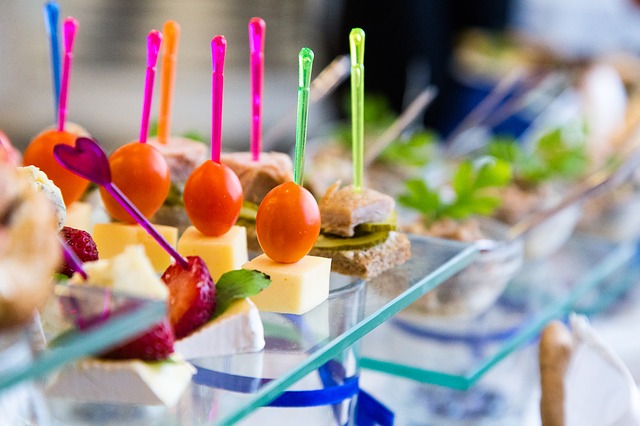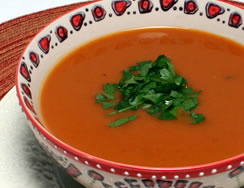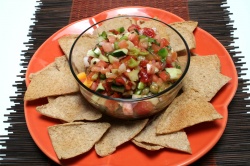Hors d’oeurve, or as we usually spell and say it, “hors d’oeuvres,” are small portions of food served before a meal to accompany drinks, alchoholic or otherwise.
In the United States, we tend to use the term hors d’oeuvre interchangeably with appetizer.
Hors d’oeuvre, literally translated, means “outside the work” of the main meal, and it is important to remember that the hors d’oeuvre course should not forecast any of the joys that are to follow.
If you serve pickled beets or anchovy eggs on tomatoes with the preliminary drinks, forget the very existence of beet and tomato when planning the dinner. This is a central concept in good menu planning.
Hors d’oeurve can be dips, spreads, pastries, olives, or nuts; they can be based on eggs, fruits, cheeses, meats, vegetables, seafood, breads. Almost anything served in portions that can be eaten with the fingers will qualify.
Canapes are a specific type of hors d’oeuvre consisting of a thin bread, cracker, or pastry base, a spread, one or more toppings, and a garnish- in effect, tiny open-faced sandwiches.
Hors d’oeuvre may be served hot, at room temperature, or cold. The selection is important, so plan the hors d’oeuvre menu with the whole dinner menu in mind, striking a balance between tastes and textures and degrees of richness.
If the meal that follows is to be rich, serve an array of simple, light hors d’oeuvre. If your menu is plainer, try more complex items with stronger flavors.
Before a dinner party, two or three kinds of hors d’oeuvre of the lighter variety are usually sufficient; you want to stimulate guests’ appetites, not sate them.
For a cocktail party without dinner to follow, prepare five or six different hors d’oeuvre, including some more substantial foods. For a reception or a party that will take the place of dinner, serve six to eight hors d’oeuvre with lots of variety and with heartier kinds added.
As a general rule, figure two pieces per person of each hors d’oeuvre at any party of party. (These lose guidelines do not include dips, which may always be included.)
Whether setting out a buffet table laden with hors d’oeuvre or passing trays of bite- sized foods, vary the shapes, sizes, colors, and textures to make the selections visually enticing.
It is usually best to choose hors d’oeuvre that don’t require last-minute cooking, so that you can spend some time with your guests before you need to finish the main meal.
If you are serving hot hors d’oeuvre, pass them after all of your guests have arrived so that everyone has the opportunity to taste them.
A microwave can speed the preparations time; use it to reheat precooked hors d’oeuvre or heat dips and sauces. Hors d’oeuvre based on bread, however, do not reheat successfully in a microwave.
Here are some hors d’oeuvres to consider:








